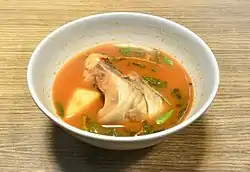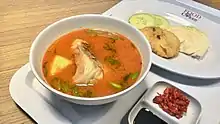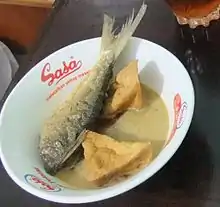Pindang
Pindang is an Indonesian[1][5] cooking method of boiling ingredients in salt and certain spices, usually employed to cook fish or egg and to some extent beef.[6]
 Pindang patin, pangasius fish in pindang soup | |
| Place of origin | Indonesia[1][2][3] |
|---|---|
| Region or state | South Sumatra—today nationwide in Indonesia, also in Brunei, Malaysia and Singapore[4] |
| Main ingredients | salt-boiled fish,[5] i.e. fish cooked in salt and spices including tamarind juice, garlic, shallot, ginger, turmeric, lemongrass, galangal, chili pepper, Indonesian bayleaf, citrus leaf, shrimp paste, and palm sugar. |
Pindang has preservative property, which used to extend the shelf life of fish. The technique is native to Java and Sumatra.[7]
Terminology
In Indonesia, various boiled fish products are generally known as pindang.[8] In Malaysia, it is known as pindang in Southwest coast of Malay peninsula, and singgang in Northeast coast of Malay peninsula,[9] althoungh not precisely the same since singgang is most likely related to Filipino sinigang instead.
Pindang is often described as Indonesian salt-boiled fish,[5] although might be enrichened and seasoned with other spices and herbs. The Malay and Indonesian dictionary describes pindang as "salted and seasoned fish, and then smoked or boiled until dry for preservation."[10][11]
In Java however, pindang refer to salt-boiled fermented fish.[1] Fermented means the fish often left to decompose further for some time. On the other hand, in Bali pindang is specifically means fish brine, where rujak kuah pindang, or Bali style fruit rujak with fish brine stock is a popular dish.[12]
The term also could refer to a specific freshly sour and spicy fish soup which uses sour-tasting spices, usually tamarind. Although pindang method and dishes could be found all across Indonesia, from Jepara and Banyuwangi in coastal Java to fishing towns of Sumatra – the pindang dish is strongly associated especially to Palembang, where pindang patin (Pangasius fish pindang) is its specialty,[2] and the province has rich variety of pindang dishes.[6]
While in Malaysia, pindang is consumed in Southwest coast of Malay peninsula, the region that facing Malacca strait and Sumatra,[9] with some region has its own variation and different names. For example, pindang recipes have been pass down for generation by Chitty, the Peranakan Tamils of Malacca that is unique to the state.[13]
As a dish

Pindang as a dish refer to a certain sour and spicy fish soup. Freshwater fish such as ikan patin (Pangasius sp.), catfish, carp or gourami are popularly used to cook pindang. However, seafood such as red snapper, milkfish, mackerel, tuna, grouper, or shrimp can be cooked as pindang as well.[14][15]
The cleaned fish flesh is boiled in water mixed in spices, including tamarind juice, garlic, shallot, ginger, turmeric, lemongrass, galangal, chili pepper, daun salam (Indonesian bayleaf), citrus leaf, shrimp paste, palm sugar and salt. The soup usually also contains pieces of chili pepper, tomato, cucumber, lemon basil and pineapple. This soupy dish has a pronounced sourness with a hint of mild sweetness and light hot spicyness.[2]
As preservation method

_in_de_visinzoutingsloods_te_Blimbing_Oost_Java_TMnr_10014130.jpg.webp)
The term pindang refer to the cooking process of boiling the ingredients in salt together with certain spices that contains tannin,[7] usually soy sauce, shallot skin, guava leaves, teak leaves, tea or other spices common in Southeast Asia. This gives the food a yellowish to brown color and lasts longer compared to plainly boiled fish or eggs, thus pindang is an Indonesian traditional method to preserve food, usually employed for fish and eggs.[7]
Pindang is regarded as one of fish preservation method through boiling with salt addition. Although the method is used in other parts of the world, it is only of major commercial significance in Southeast Asia. The shelf life of the products varies from one or two days to several months.[8] The technique is native to Java and Sumatra. In Indonesia, various preserved pindang fish are available in traditional markets. Common fish being processed as pindang are tongkol (mackerel tuna or Euthynnus), bandeng (milkfish), kembung (mackerel or Rastrelliger), lejang (Decapterus), and also kuwe or cue (Caranx sp.).[8]
Pindang preparation is often called the "wet preservation", i.e. after covered in coarse salt, instead of being dried in the sun like salted fish, it is boiled on a low flame until the liquids are evaporated and the salt seasoning absorbed well into fish.[16] Compared to salted fish, pindang uses less salt, thus the taste is not as salty as salted fish. Other preserving methods common in Indonesian cuisine include asin (salted) or cured and dried in salt, and dendeng which is cured and dried in sugar, acar (pickling), and also asap (smoked).[1]
Variants

Pindang variants can be differentiated according to the kind of fish species used, or according to specific regional recipes which use different ingredients and spices combination. Pindang recipes can be found in various cooking traditions of Southeast Asia; from Javanese, Betawi, Palembang, and Malay cuisine. In Indonesia, pindang recipes show exceptional diversity in South Sumatra.[6]

- Pindang bandeng or pindang serani: Milkfish pindang, specialty of Betawi, Jakarta.[17] The name "serani" is corrupted from nasrani or Christian, which refer to Mardijker of Kampung Tugu in North Jakarta.[17] Pindang serani is also common in Jepara, Central Java, is made from various kinds of seafood, but the most popular one is milkfish.[18]
- Pindang gabus: Snakehead pindang, specialty of South Sumatra.[19]
- Pindang kerupuk: Pindang soup that uses krupuk keriting, fish cracker, specialty of South Sumatra.[6] Using krupuk cracker in soup is quite similar to Sundanese seblak.
- Pindang meranjat or pindang salai: the most hot and spicy South Sumatran pindang variant from Meranjat village, Ogan Komering Ilir Regency, uses iwak salai (smoked fish) made from catfish, patin, baung, or lais fish.[20][6]
- Pindang musi rawas: Sour and fresh pindang from Musi Rawas, South Sumatra, which unlike other variants uses mashed tomato instead of tamarind as its souring agent.[20]
- Pindang palembang or pindang patin: Pangasius pindang, specialty of Palembang.[2][6]
- Pindang pegagan: This pindang variant uses turmeric and chili pepper. Its soup is light and not oily, since the spices are boiled directly, and not stir fried in palm oil.[20]
- Pindang sekayu: Sweet tasting fish pindang from Sekayu, Musi Banyuasin, using a sweet soy sauce.[20]
- Pindang telur: Eggs cooked using pindang process, widely spread throughout the archipelago, but it is found more prevalent in Javanese cuisine .[21] and Johor cuisine[22]
- Pindang telur gabus: Pindang that uses fish roe of gabus, snakehead's egg, specialty of South Sumatra.[6]
- Pindang tongkol: A pindang variant using pindang processed mackerel tuna.[23]
- Pindang tulang: Lit: bone pindang, beef ribs pindang, also specialty of Palembang, South Sumatra.[6]
- Pindang nenas udang: A Melaka Chetti pindang variant using prawn.
- Pindang ikan parang: A Melaka Chetti pindang variant using coconut milk.
- Pindang kerang/sotong: A Perak Malay pindang variant using cockles or squid, a specialty of Lenggong Valley, Perak.
- Pindang pegaga: Negeri Sembilan pindang variant using pegaga leaf.
- Pindang telur itik: Negeri Sembilan pindang variant using duck egg.
- Pindang hati ayam dan kacang botol: Negeri Sembilan pindang variant using chicken heart and vegetables.[24]
See also
- Pekasam, a similar fish preservation method of Banjarese and Malay origin
- Asam pedas, a similar dish of Minangkabau and Malay origin
- Tom yum, a similar dish from Thailand
- Sinigang, a similar dish from the Philippines
References
- Costa-Pierce, Barry A.; Soemarwoto, Otto (1990-01-01). Reservoir Fisheries and Aquaculture Development for Resettlement in Indonesia. WorldFish. ISBN 978-971-10-2250-1.
- "Pindang Patin Palembang" (in Indonesian).
- Bangun Permadi. "Pindang Sebagai Bentuk Akulturasi Budaya Sumatera Selatan di Provinsi Lampung". Universitas Ciputra.
- http://eprints.usm.my/35749/1/norfarizan_jurnal_pengguna_malaysia_%281%29.pdf
- Hall, George M. (1997-07-31). Fish Processing Technology. Springer Science & Business Media. p. 61, 62. ISBN 978-0-7514-0273-5.
- "5 Jenis Olahan Pindang Khas Sumatera Selatan". kumparan (in Indonesian). Retrieved 2020-10-01.
- "Pengolahan Jamur Komersial, Jahe Instan, Ikan Asap, Telur Pindang" (PDF) (in Indonesian). Jurusan Teknologi Pangan dan Gizi-IPB. pp. 103–104. Bogor. Archived from the original (PDF) on 2014-04-13.
- "Fish Handling, Preservation and Processing in the Tropics: Part 2 (NRI): Boiled fish products". www.nzdl.org. Retrieved 2020-10-02.
- Majid, Fadzilah Adibah Abdul. "Ikan Singgang Berkhasiat Sebagai Makanan Berfungsi Untuk Penjagaan Kesihatan". Cite journal requires
|journal=(help) - https://prpm.dbp.gov.my/Cari1?keyword=pindang
- "Pindang". Kamus Besar Bahasa Indonesia (in Indonesian).
pindang/pin·dang/ n ikan yang digarami dan dibumbui kemudian diasapi atau direbus sampai kering agar dapat tahan lama
- Eats, Indonesia (2013-02-03). "Indonesian Fish Brine Recipe (Ikan Pindang) » Indonesia Eats". Indonesia Eats. Retrieved 2020-10-01.
- https://www.thestar.com.my/lifestyle/family/2019/10/04/chetti-culinary-staples
- "16.036 resep aneka olahan pindang enak dan sederhana ala rumahan". Cookpad (in Indonesian). Retrieved 2020-10-02.
- DeMedia, TimDapur (2007-01-01). Aneka Masakan Ikan Nusantara (in Indonesian). DeMedia. ISBN 978-979-1471-12-1.
- "Fish on the menu". The Jakarta Post. 1 August 2010. Retrieved 2020-10-01.
- Tourism, jakarta (2018-02-26). "Pindang Bandeng Betawi". jakarta-tourism.go.id (in Indonesian). Retrieved 2020-10-01.
- "Pindang Serani khas Jepara". Cookpad (in Indonesian).
- "Common Snakehead (Channa striata)". SEAFDEC/IFRDMD. 2020-05-18. Retrieved 2020-10-01.
- "Lima Pindang Khas Sumatera Selatan". Laskar Wong Kito (in Indonesian).
- "Membuat Telur Pindang yang Lezat dan Cantik" (in Indonesian). Bango. Archived from the original on 2 April 2015. Retrieved 12 March 2015.
- http://ebuletin.mardi.gov.my/buletin/06/Effendi%20(Telur%20Pindang).pdf
- "Makan Siang Seketika Jadi Spesial karena Pindang Tongkol Enak Ini, Yuk Kita Tiru Resepnya!". Bangka Pos (in Indonesian). 1 March 2019. Retrieved 2020-10-01.
- https://docs.google.com/viewerng/viewer?url=http://malaycivilization.com.my/omeka/files/original/4e675c45b3587aabf71415dcb28d9f16.pdf
External links
- Pindang Patin Palembang (Cookpad)
- Ikan Pindang, Indonesian Fish Brine Recipe (Indonesia Eats)
